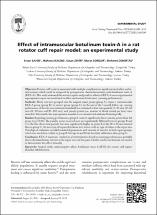Effect of intramuscular botulinum toxin-A in a rat rotator cuff repair model: An experimental study
Künye
Şahin, E., Kalem, M., Zehir, S., Songür, M., Demirtaş M. (2015). Effect of intramuscular botulinum toxin-A in a rat rotator cuff repair model: an experimental study. Acta Orthopaedica et Traumatologica Turcica, 49(4), 447-452.Özet
Objective: Rotator cuff repair is associated with multiple complications, significant morbidity, and reintervention, which could be mitigated by postoperative chemodeneveration with botulinum toxin-A (BTX-A). This study evaluated the antinociceptive and paralytic effects of BTX-A on an experimental supraspinatus repair rat model and its effect on functional outcomes (running performance). Methods: Thirty rats were grouped into the surgical repair group (group A), repair + intramuscular BTX-A group (group B), or control group (group C). At the end of the 3-month follow-up, running performance of the rats on a motorized treadmill was evaluated in four time periods (0-30 min, 30-60 min, 60-90 min, and 90-110 min), and penalty points (i.e., number of shock stimuli per lane) were recorded. Afterwards, the supraspinatus muscles were removed and evaluated histologically. Results: Regarding running performance, group B received significantly fewer penalty points than did group A (p<0.05). The penalty points received were not significantly different between groups B and C in the first three time periods, but were significantly higher in group B at the 90-110-min interval than in group C. On necropsy, all repaired tendons were intact, with no sign of failure at the repair site. Histological evaluation revealed marked degeneration and necrosis of muscles in both repair groups, which was much less evident in group B. Groups A and B had less fatty infiltration than group C. Conclusion: BTX-A injections resulted in a better function based on running performance, probably due to decreased tissue tension at the repair site and less pain. Further studies on humans are needed to demonstrate this effect clinically. © 2015 Turkish Association of Orthopaedics and Traumatology.


















